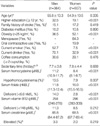1. Ford ES, Ajani UA, Croft JB, Critchley JA, Labarthe DR, Kottke TE, Giles WH, Capewell S. Explaining the decrease in U.S. deaths from coronary disease, 1980-2000. N Engl J Med. 2007. 356:2388–2398.

2. Murray CJ, Lopez AD. Mortality by cause for eight regions of the world: Global Burden of Disease Study. Lancet. 1997. 349:1269–1276.

3. Korea National Statistical Office. Annual Report on the Cause of Death Statistics in 2006. 2007. Daejeon, Korea: Korea National Statistical Office.
4. Wang X, Qin X, Demirtas H, Li J, Mao G, Huo Y, Sun N, Liu L, Xu X. Efficacy of folic acid supplementation in stroke prevention: a meta-analysis. Lancet. 2007. 369:1876–1882.

5. Bonaa KH, Njolstad I, Ueland PM, Schirmer H, Tverdal A, Steigen T, Wang H, Nordrehaug JE, Arnesen E, Rasmussen K. Homocysteine lowering and cardiovascular events after acute myocardial infarction. N Engl J Med. 2006. 354:1578–1588.

6. McNulty H, Pentieva K, Hoey L, Ward M. Homocysteine, B-vitamins and CVD. Proc Nutr Soc. 2008. 67:232–237.

7. Graham IM, Daly LE, Refsum HM, Robinson K, Brattstrom LE, Ueland PM, Palma-Reis RJ, Boers GH, Sheahan RG, Israelsson B, Uiterwaal CS, Meleady R, McMaster D, Verhoef P, Witteman J, Rubba P, Bellet H, Wautrecht JC, de Valk HW, Sales Luis AC, Parrot-Rouland FM, Tan KS, Higgins I, Garcon D, Medrano MJ, Candito M, Evans AE, Andria G. Plasma homocysteine as a risk factor for vascular disease. The European Concerted Action Project. JAMA. 1997. 277:1775–1781.
8. Refsum H, Ueland PM, Nygard O, Vollset SE. Homocysteine and cardiovascular disease. Annu Rev Med. 1998. 49:31–62.
9. Nygard O, Vollset SE, Refsum H, Brattstrom L, Ueland PM. Total homocysteine and cardiovascular disease. J Intern Med. 1999. 246:425–454.

10. Lim HS, Nam KS, Heo YR. The relationships of health-related life-styles with homocysteine, folate, and vitmain B12 status in Korean adults. Korean J Community Nutr. 2001. 6:507–515.
11. Min H. Folate status and plasma homocysteine concentration of Korean adults. Korean J Nutr. 2001. 34:393–400.
12. Hao L, Ma J, Zhu J, Stampfer MJ, Tian Y, Willett WC, Li Z. High prevalence of hyperhomocysteinemia in Chinese adults is associated with low folate, vitamin B-12, and vitamin B-6 status. J Nutr. 2007. 137:407–413.

13. Kim JU, Kim HJ, Choi BY. Normal value for serum homocysteine and the prevalence of hyperhomocysteinemia in a rural population. Korean J Epidemiol. 2008. 30:100–109.

14. Clinical and Laboratory Standards Institute. How to Define and Determine Reference Intervals in the Clinical Laboratory; Approved Guideline. 2000. Wayne, Pennsylvania: Clinical and Laboratory Standards Institute.
15. Herbert V. Shils ME, Olson JA, Shike M, Ross AC, editors. Folic acid. Modern Nutrition in Health and Disease. 1999. 9th ed. Baltimore: Williams & Wilkins;433–446.
16. Weir DG, Scott JM. Shils ME, Olson JA, Shike M, Ross AC, editors. Vitamin B12 "cobalamin". Modern Nutrition in Health and Disease. 1999. 9th ed. Baltimore: Williams & Wilkins;447–458.
17. Selhub J, Jacques PF, Rosenberg IH, Rogers G, Bowman BA, Gunter EW, Wright JD, Johnson CL. Serum total homocysteine concentrations in the third National Health and Nutrition Examination Survey (1991-1994): population reference ranges and contribution of vitamin status to high serum concentrations. Ann Intern Med. 1999. 131:331–339.

18. Steering Committee of the Western Pacific Region of the World Health Organization. The International Association for the Study of Obesity and the International Obesity Task Force. The Asia-Pacific Perspective: Redefining Obesity and Its Treatment. 2000. Melbourne: Health Communications Australia Pty Ltd;8–56.
19. Piyathilake CJ, Macaluso M, Hine RJ, Richards EW, Krumdieck CL. Local and systemic effects of cigarette smoking on folate and vitamin B-12. Am J Clin Nutr. 1994. 60:559–566.

20. Hamid A, Wani NA, Rana S, Vaiphei K, Mahmood A, Kaur J. Down-regulation of reduced folate carrier may result in folate malabsorption across intestinal brush border membrane during experimental alcoholism. FEBS J. 2007. 274:6317–6328.

21. Adachi H, Hirai Y, Fujiura Y, Matsuoka H, Satoh A, Imaizumi T. Plasma homocysteine levels and atherosclerosis in Japan: epidemiological study by use of carotid ultrasonography. Stroke. 2002. 33:2177–2181.
22. Shimakawa T, Nieto FJ, Malinow MR, Chambless LE, Schreiner PJ, Szklo M. Vitamin intake: a possible determinant of plasma homocyst(e)ine among middle-aged adults. Ann Epidemiol. 1997. 7:285–293.

23. Saw SM, Yuan JM, Ong CN, Arakawa K, Lee HP, Coetzee GA, Yu MC. Genetic, dietary, and other lifestyle determinants of plasma homocysteine concentrations in middle-aged and older Chinese men and women in Singapore. Am J Clin Nutr. 2001. 73:232–239.

24. Kim MK, Ordovas JM, Selhub J, Campos H. B vitamins and plasma homocysteine concentrations in an urban and rural area of Costa Rica. J Am Coll Nutr. 2003. 22:224–231.

25. Korea Ministry of Health and Welfare. The Third Korea National Health and Nutrition Examination Survey (KNHANES III). 2006. Kwacheon, Korea: Ministry of Health and Welfare.
26. Gartler SM, Hornung SK, Motulsky AG. Effect of chronologic age on induction of cystathionine synthase, uroporphyrinogen I synthase, and glucose-6-phosphate dehydrogenase activities in lymphocytes. Proc Natl Acad Sci USA. 1981. 78:1916–1919.

27. Brattstrom L, Lindgren A, Israelsson B, Andersson A, Hultberg B. Homocysteine and cysteine: determinants of plasma levels in middle-aged and elderly subjects. J Intern Med. 1994. 236:633–641.
28. Hak AE, Polderman KH, Westendorp IC, Jakobs C, Hofman A, Witteman JC, Stehouwer CD. Increased plasma homocysteine after menopause. Atherosclerosis. 2000. 149:163–168.

29. Nygard O, Vollset SE, Refsum H, Stensvold I, Tverdal A, Nordrehaug JE, Ueland M, Kvale G. Total plasma homocysteine and cardiovascular risk profile. The Hordaland Homocysteine Study. JAMA. 1995. 274:1526–1533.
30. Nygard O, Refsum H, Ueland PM, Stensvold I, Nordrehaug JE, Kvale G, Vollset SE. Coffee consumption and plasma total homocysteine: The Hordaland Homocysteine Study. Am J Clin Nutr. 1997. 65:136–143.








 PDF
PDF ePub
ePub Citation
Citation Print
Print




 XML Download
XML Download